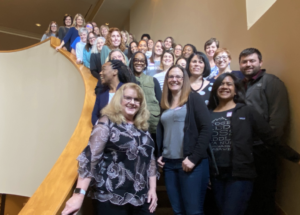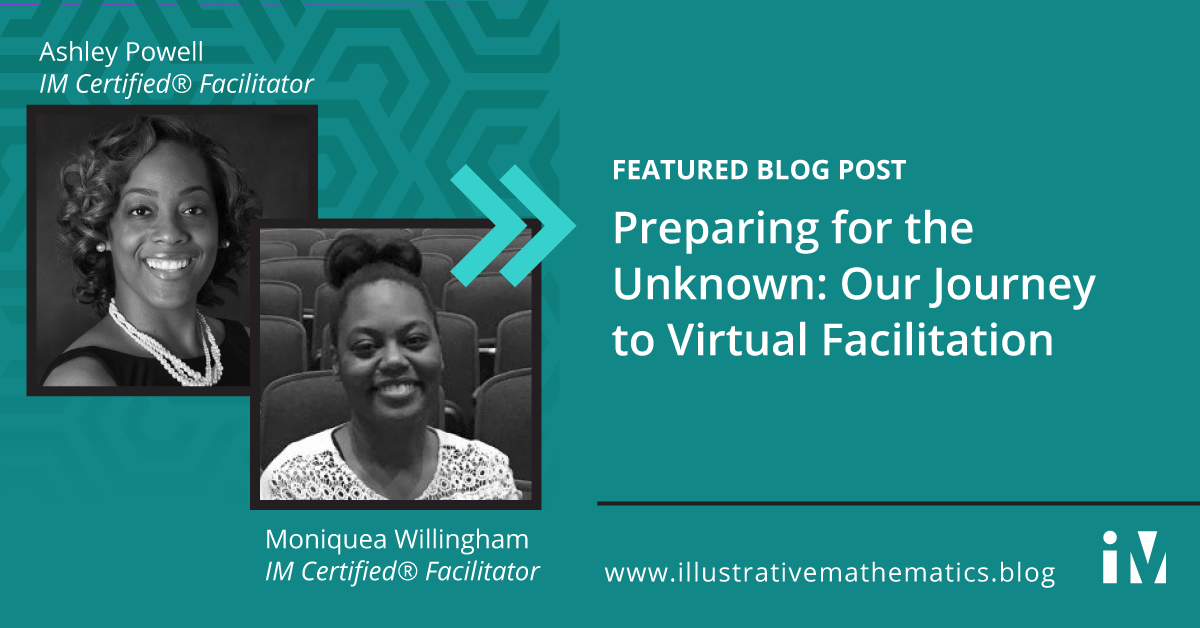 By Ashley Powell and Moniquea Willingham
By Ashley Powell and Moniquea Willingham
The excitement and nervousness in the room was almost palpable! There were approximately forty facilitators present for the 3-day IM K–5 Curriculum training in Dallas, Texas. We completely immersed ourselves into the curriculum and its components, practiced in-person facilitation moves, and made meaningful connections with one another and our incredible support team. It was an awesome experience! We all walked away feeling more confident about facilitating professional learning in school districts across the United States.
Then COVID-19 hit and stopped us in our tracks. The ability to travel became extremely limited or nonexistent. Schools began closing down and moving to the virtual space, including the district where we work. Naturally, there was a need for IM and its facilitators to follow. However, it was difficult to imagine how we would adjust for the “new normal”.
Unchartered Territory
The IM Professional Learning team is knowledgeable and extremely supportive. They understood we were entering uncharted territory. We attended new trainings designed to help us facilitate remotely. This was a new challenge and we were up for it. As educators, we understand how important it is to be flexible and responsive to the situation in front of us. The following is how we navigated and prepared ourselves for the “new normal” known as virtual facilitation.
Content Learning Walks
The authors of the professional learning identified the most important elements in the curriculum, the mathematical content, and the professional learning sessions. During our new training sessions, we went slide by slide, examining the elements. We were able to openly ask questions and seek clarification from the authors and the other facilitators.
Practice, Practice, Practice
They say practice makes perfect and that was our goal. Facilitators made appointments with one another on Zoom to get a feeling of how it would be to present virtually. We offered one another encouragement and feedback. This allowed us to continue to learn the content and become more comfortable with the idea of facilitating in the virtual space. The practice sessions made all the difference in the world!
Embracing Experimentation
The virtual space required many of the facilitators to navigate technology in new and different ways. Some of us purchased new equipment, such as tablets and a stylus to allow for an even more interactive experience. Additionally, many of us began to use dual monitors for the first time. This required time and effort prior to facilitation in order to make sure the view was conducive to participant learning. One screen was used primarily for the facilitation of the presentation and participant-facing components and the other for facilitator-facing items such as slide deck notes and access to the other tools being used for engagement.
Rules of engagement
The many educators we had planned to greet and engage face-to-face were now black squares on our screens. Their increasing angst about their new curriculum permeated the space. Virtual facilitation requires one to be technologically savvy and efficient while delivering content and adapting learning experiences to our audience. Traditional engagement of learners begins with body language, visual cues to gauge interest, confusion, and collaboration. Now, instead of reading the room, we have to read the body language through broadband. To do this intentionally, facilitators have to keep track of participation for many people at once while monitoring inactivity. We also have to balance the content delivery with application.
Our goal was to avoid the mistake made by so many: the assumption that the traditional environment and the virtual space would behave similarly. This two-hour main event had to be innovative, practical and most of all beneficial to each participant if we wanted them to leave the session and not revert to the status quo of relying on virtual worksheets. With more than 20 professional learning sessions between us in June we were executing this virtual process with ease. One participant said “Thank you for creating such an engaging virtual PD! I was worried about the level of engagement doing it online, but I think you all did an excellent job of helping people stay focused by mixing things up and changing to different activities.”
Tool for engagement
So here is how we changed the game for the IM K–5 Curriculum users. We designed learning experiences instead of lecture-heavy webinars. During an IM virtual professional learning session, participants develop content knowledge, and receive curriculum guidance and virtual moves they can embed in their own practice.
- Jamboard allows us to create collaborative spaces to share, display, and model thinking. Facilitators annotated participant thinking during Number Talks, and then participants had the opportunity to rehearse the routines themselves.
- Slido offers quick results for feedback, anonymity with prompts, and even a Q&A feature to use for next steps.
- Zoom breakout rooms afford participants the opportunity to work in small groups, especially critical while we are socially distant. Many times, we found that educators were sharing personal stories and getting to know one another instead of working on the task at hand. Teachers needed that space to build trust to ready themselves for the challenging work ahead.
Benefits for teachers and students
We rehearse instructional routines during the professional learning because we want to empower teachers to empower students. Positioning students as agents of their own learning helps them engage deeply with mathematics and build their mathematical identity. The instructional routines within the curriculum are designed to push student mathematical thinking forward while addressing issues of equity within the classroom.
A world where all learners know, use, and enjoy mathematics is only achievable when teachers are able to tell a coherent mathematical story. As certified facilitators, we skillfully crafted professional learning that valued quality and focus and completes the IM K–12 Math continuum.
A participant in the K–5 professional learning offered this comment: “This training was well thought out and provided rich experiences for teachers who are receptive and willing to work through virtual glitches. The facilitators were powerful modelers of best practices for virtual learning—providing strategies for engaging learners. Everyone was persistent and delivered what was expected. Many thanks to our facilitators who provided positive energy and tackled some tough situations. This was impressive.” We would not have it any other way.
Next Steps
One of the most important next steps is for you to breathe! This is a challenging time in education so give yourself some grace. Just start small. Become fluent with one tool that will connect the dots for your learners, enrich their experience, and enhance your delivery approach.
To learn more about IM’s professional learning catalog and facilitator training, visit the following website:
https://illustrativemathematics.org/professional-learning/
